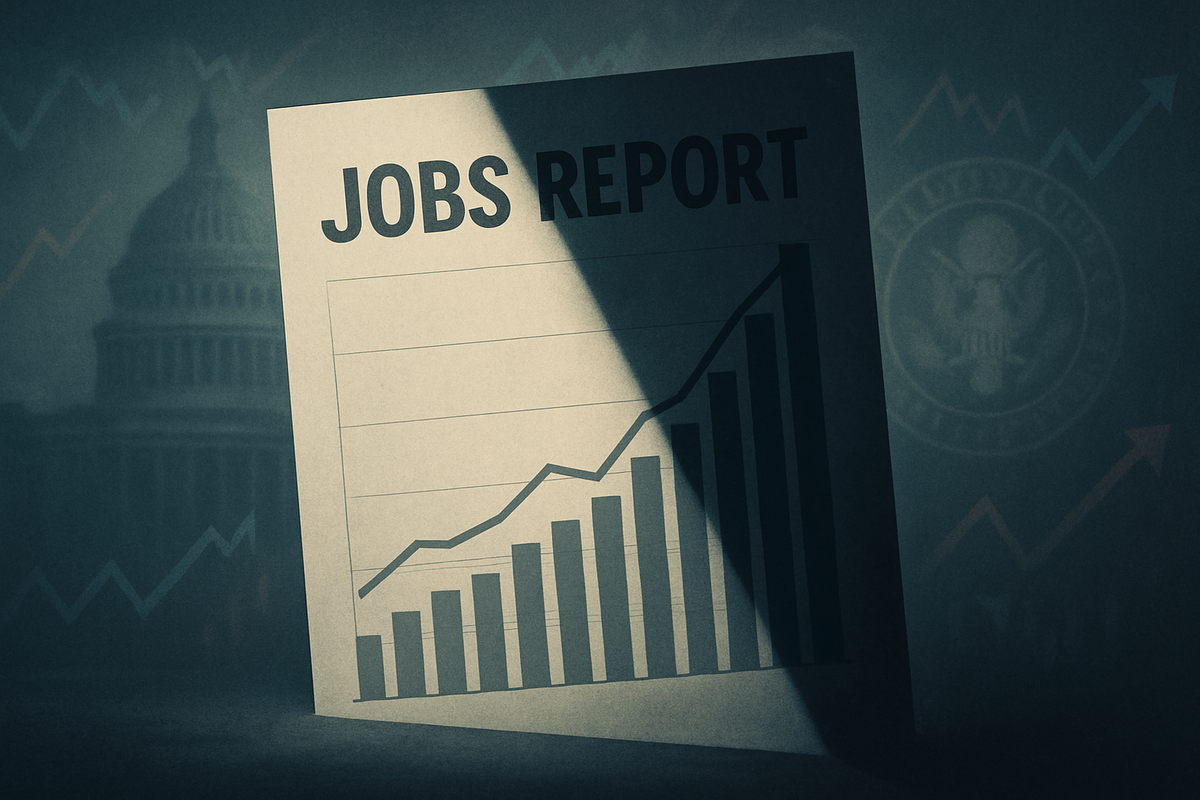
Washington D.C., October 2, 2025 – As a federal government shutdown extends into its second day, the highly anticipated U.S. Jobs Report, typically released on the first Friday of each month, has been delayed indefinitely. This immediate consequence of the government's funding lapse creates a significant blind spot for policymakers and investors grappling with an already uncertain economic landscape. The delay underscores the critical role of timely government data in navigating the nation's economic health and setting monetary policy.
The absence of this crucial economic indicator comes at a sensitive time for the U.S. economy. With signs of a weakening labor market, including slowing job growth and a projected unemployment rate of 4.3% for September, coupled with persistent inflation, the Federal Reserve (Fed) and financial markets are left without essential, up-to-date information. This "data blackout" not only amplifies uncertainty but also complicates the Fed's critical decisions regarding interest rates, potentially leading to increased market volatility.
The Data Blackout: Specifics of the Shutdown's Impact
The U.S. Department of Labor (DOL) and its Bureau of Labor Statistics (BLS) are the primary agencies responsible for producing the comprehensive monthly Employment Situation Report. Under a federal government shutdown contingency plan, the BLS suspends all non-essential operations. This means that data collection, processing, and dissemination activities for BLS surveys cease, and website updates are halted. BLS employees involved in these functions are typically classified as "nonessential" and are furloughed.
The September Employment Situation Report, which includes vital information on payrolls, the unemployment rate, and average hourly earnings, was originally scheduled for release on Friday, October 3, 2025. Due to the shutdown, this report has been delayed indefinitely. While the BLS had reportedly completed most of the work for the September report before the shutdown, suggesting it could be published quickly once government operations resume, a prolonged shutdown carries the risk of not only delayed reports but also a potential reduction in the quality of data collected for future reports. Beyond the Jobs Report, other critical data, such as weekly jobless claims, the Consumer Price Index (CPI) due October 15, and the Producer Price Index (PPI) due October 16, are also at risk of delay.
Historically, federal government shutdowns have led to similar data delays. During the October 2013 shutdown, which lasted 16 days, the September 2013 jobs report was delayed by approximately two weeks. Similarly, the September CPI was eventually published two weeks late. However, in the longer 2018-2019 shutdown, BLS reports were largely unaffected due to prior congressional funding. The current situation, however, sees the BLS fully impacted. Initial market reactions have been cautiously measured, with some stock dips and a surge in gold as investors seek safe havens. The primary concern for investors and policymakers is the "data vacuum" created, especially given the Federal Reserve's data-dependent approach to interest rate decisions.
Companies and Sectors Navigating the Uncertainty
The delay of the U.S. Jobs Report and the broader federal shutdown introduce significant uncertainty, creating distinct winners and losers across various sectors.
Potential Losers:
- Government Contractors: Companies with significant federal contracts face immediate negative impacts. Firms like Lockheed Martin (NYSE: LMT), Boeing (NYSE: BA), and IT service providers such as Booz Allen Hamilton (NYSE: BAH) may experience delayed payments, suspended new contract awards, and disruptions to ongoing projects. Unlike furloughed federal employees, contractors are not guaranteed back pay, which can severely impact their cash flow and revenue.
- Sectors Sensitive to Economic Indicators: Financials, Industrials, Energy, and Retail sectors are particularly vulnerable. Without reliable data on labor market health, inflation, and consumer spending, businesses in these areas struggle to forecast demand, make investment decisions, and manage supply chains. Financial institutions, for instance, face challenges in credit scoring and regulatory compliance, while retailers and consumer discretionary companies may see reduced consumer spending due to eroded confidence and potential federal worker furloughs. The housing market could also see a decline in mortgage applications as federal systems processing mortgages are put on hold.
- Travel and Tourism: This sector is highly exposed, with potential national park closures, airport disruptions due to understaffing (e.g., TSA, air traffic control), and reduced consumer travel leading to significant revenue losses.
Potential Winners (or those more resilient):
- Safe-Haven Assets: In times of political uncertainty and increased risk aversion, investors often flock to traditional safe havens. Gold and precious metals typically see a surge in prices, while U.S. Treasury bonds may also rally as investors seek stability, causing yields to drop.
- Defensive Sectors: Companies providing essential goods and services tend to be more resilient during economic downturns or uncertainty. Consumer staples (e.g., Post Holdings (NYSE: POST)) and utilities (e.g., American Electric Power Company (NASDAQ: AEP)) often outperform, as consumer demand remains relatively stable.
- Technology Companies (with diversified global revenue): Large technology companies with diverse revenue streams and a strong global presence, such as Microsoft (NASDAQ: MSFT) or Nvidia (NASDAQ: NVDA), are often less directly impacted by U.S. government shutdowns, relying more on international markets or private sector demand.
- Healthcare (Essential Services): While some healthcare stocks can experience volatility, essential healthcare services generally continue. Providers of essential services are less likely to see significant operational disruptions, and pharmaceutical and biotech companies (e.g., Merck (NYSE: MRK), Amgen (NASDAQ: AMGN)) may be viewed as stable picks.
Wider Significance and Historical Context
The delay of the U.S. Jobs Report due to a federal government shutdown carries significant wider implications, extending beyond immediate data unavailability to affect broader industry trends, global competitors and partners, and regulatory policy.
The absence of crucial labor market data leaves policymakers, particularly the Federal Reserve, "flying blind" at a critical juncture. With inflation reportedly running above its 2% target and hiring nearly stalled, the Fed faces conflicting signals regarding interest rate decisions, making it difficult to assess the economy accurately before its late October meeting. This uncertainty can exacerbate market volatility, lead to delayed business decisions, and tighten credit supply, as firms postpone investment and hiring.
Internationally, the U.S. economy's interconnectedness means a Jobs Report delay has global ramifications. International investors may become more cautious about allocating capital, viewing the U.S. market as less predictable, leading to increased volatility in global financial markets. Multinational corporations with significant U.S. operations can face regulatory backlogs and disrupted global logistics. Furthermore, the U.S. dollar may fluctuate, impacting global currencies and trade.
Historically, government shutdowns have had marginal effects on the broader economy, with direct GDP losses often partially recouped. For example, the 16-day shutdown in 2013 reduced real GDP growth by 0.3 percentage points in the fourth quarter. However, the current economic environment, characterized by an already weakening labor market, sticky inflation, and ongoing trade policy uncertainties, makes this shutdown more precarious than previous ones. This means the economy may be less resilient to the added shock of data blackouts and government dysfunction, increasing the risk of more severe consequences.
What Comes Next: Navigating the Data Void
The future trajectory hinges significantly on the duration of the federal shutdown. A swift resolution would likely limit lasting economic damage, while a prolonged impasse could have more significant and enduring effects on the economy and markets.
In the short-term, the most immediate impact is the continued suspension of critical economic reports. This creates a "flying blind" scenario for investors and policymakers. The Federal Reserve's upcoming meeting on October 28-29 will be particularly challenging, as they must make interest rate decisions without crucial data. Markets and economists will increasingly rely on private-sector indicators, such as the ADP monthly employment data, which recently showed a cut of 32,000 private sector jobs in September, garnering increased attention.
Long-term possibilities include an erosion of confidence and potential economic growth if the shutdown is prolonged. Each week of the shutdown could trim GDP growth, and while federal workers typically receive back pay, their discretionary spending decreases, with related GDP losses only partially recouped. A sustained lack of reliable data could hamper the Federal Reserve's ability to implement effective monetary policy, extending periods of economic uncertainty. There are also concerns about potential permanent federal job cuts, which would have a more significant impact than temporary furloughs.
Strategic pivots for businesses will involve diversifying revenue streams, building larger cash reserves, and increasingly relying on alternative data sources and agile planning. Policymakers, particularly the Federal Reserve, will need to rely more on non-official data and business surveys, potentially exercising greater caution in monetary policy decisions until more clarity emerges. The most significant adaptation, however, is a swift political resolution to restore the flow of critical economic information. Market opportunities may emerge in safe-haven assets and defensive sectors, while challenges include increased volatility and sector-specific headwinds.
Comprehensive Wrap-Up: A Market in Limbo
The U.S. Jobs Report is a cornerstone of economic analysis, providing crucial insights into job creation, unemployment rates, and wages—figures vital for understanding consumer spending and influencing the Federal Reserve's monetary policy. Its delay due to the federal shutdown leaves markets and policymakers in an unprecedented state of uncertainty, especially given the current economic climate of slowing growth and persistent inflation.
The market moving forward will likely remain volatile, with investors scrutinizing any available private-sector data and eagerly awaiting the resumption of official government reports. The Federal Reserve faces a formidable challenge, needing to make critical interest rate decisions without its most reliable economic compass. This situation underscores the deep interconnectedness of government functionality and market stability.
The lasting impact of this event hinges on its duration. While short shutdowns have historically had limited long-term economic effects, a prolonged data blackout and government dysfunction could erode trust, dampen consumer and business confidence, and potentially lead to more significant economic drag. Beyond economic figures, regulatory bottlenecks and disruptions to federal services can have widespread, lagged impacts across various industries.
What Investors Should Watch For in Coming Months:
- Duration of the Shutdown: The speed of a political resolution will dictate the severity of economic and market impacts.
- Private Sector Data: Pay close attention to alternative private-sector indicators for clues on labor market health and consumer activity.
- Federal Reserve's Stance: The Fed's actions and communications at its late October meeting will be paramount, particularly how it addresses the data void.
- Resumption of Official Data: Once the government reopens, the release schedule and content of delayed reports will trigger significant market reactions.
- Congressional Action: Monitor political developments closely, as underlying disagreements could influence future government stability.
In an already complex economic environment marked by slowing growth and persistent inflation, the delayed Jobs Report due to the federal shutdown adds an unwelcome layer of opacity. Navigating this period will require investors to maintain a sharp focus on alternative data sources and the evolving political landscape, while anticipating a deluge of crucial economic information once government operations resume.
This content is intended for informational purposes only and is not financial advice.






